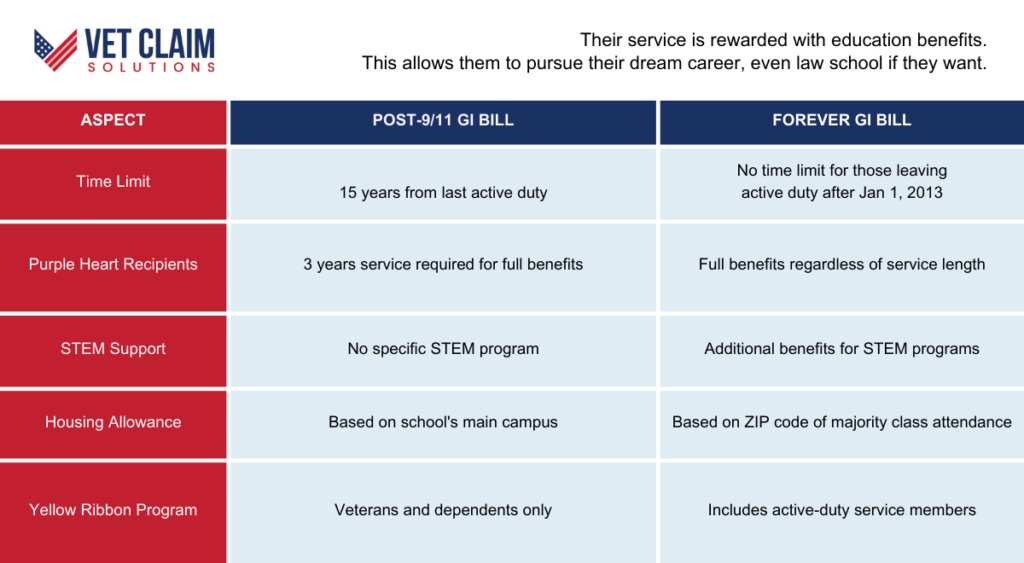Veterans who have served our country deserve the best support we can offer as they transition to civilian life. Education benefits are a crucial part of that support. Understanding the Forever GI Bill vs Post 9/11 GI Bill is important for service members planning their futures.
Both bills help service members and veterans pursue higher education. However, key differences significantly impact eligibility and education benefits.
The Post-9/11 GI Bill, enacted in 2008, provided education benefits to those who served after September 11, 2001. The Montgomery GI Bill offered more comprehensive coverage than previous versions. In 2017, Congress passed the Harry W. Colmery Veterans Educational Assistance Act, known as the Forever GI Bill, which enhanced the Post-9/11 GI Bill, expanding benefits for veterans and their families.
Expanded Eligibility and Benefits
One major change is the removal of the time limit for using benefits. The Post-9/11 GI Bill had a 15-year limit from the last day of active duty. The Forever GI Bill eliminates this for those who left active duty on or after January 1, 2013.
This change acknowledges that not all veterans can pursue higher education immediately after leaving service. Life circumstances or career paths may delay education plans. The Forever GI Bill offers flexibility.
The Forever GI Bill also broadened eligibility for full benefits. Purple Heart recipients previously needed at least three years to get 100% of the benefit.
The Forever GI Bill now grants all Purple Heart recipients who served on or after September 11, 2001, full benefits. This is regardless of their length of military service.
This change honors the sacrifices made and grants access to education support. Another improvement is the expansion of benefits for STEM programs.
The Forever GI Bill established the Edith Nourse Rogers STEM Scholarship. It provides up to nine additional months of benefits or a lump sum of up to $30,000 for students pursuing STEM degrees. This encourages veterans to enter high demand technical fields.
Housing Allowance and Yellow Ribbon Program Changes
The Forever GI Bill also made changes to the housing allowance calculation. The Post-9/11 GI Bill based the Monthly Housing Allowance (MHA) on the school’s main campus location.
The Forever GI Bill now calculates the MHA based on where the student attends most of their classes. This change reflects the cost of living, especially for online classes.
The Forever GI Bill expanded the Yellow Ribbon Program to active duty service members. The ribbon program, helps cover costs beyond the GI Bill at private colleges. It was previously only for veterans and dependents.
Starting August 1, 2022, active-duty service members can also access Yellow Ribbon Program benefits. It opened up educational opportunities while still serving in the armed forces.

Support for Reservists and National Guard Members
The Forever GI Bill vs Post 9/11 comparison also shows better support for Reservists and National Guard members. The new legislation expanded GI Bill eligibility.
This happens for service members called to active duty for national emergencies or federal disaster response. This acknowledges their role in domestic crises.

Benefit Transfer and Restoration
The Forever GI Bill also changed benefit transfer rules. It allows veterans who transferred their Post-9/11 GI Bill benefits to reassign them if the recipient dies.
This gives families flexibility and the education benefit doesn’t go unused. The Forever GI Bill includes ways for restoring benefits to students affected by school closures.
This protects veterans from losing benefits due to sudden school shutdowns.
Implementation Challenges
While the Forever GI Bill shows improvements, implementing these changes hasn’t been easy. The VA faced issues in updating its IT systems, as reported by Task and Purpose.
The department hired temporary workers to process VA claims manually. The goal was for veterans to receive their benefits.
These issues show the difficulty of modernizing large government programs. However, the VA is working to address these challenges and improve the delivery of benefits.
Impact on Veterans’ Education and Careers
The Forever GI Bill has impacted veterans’ educational opportunities. Removing time limits and expanding eligibility has made it easier for veterans to pursue higher education.
This benefits individual veterans and the nation’s technological areas. The support of continued education will ensure an easy transition.
The expanded Yellow Ribbon Program and improved housing allowance calculations have made attending private institutions feasible. This broadens the educational options for veterans limited by finances.
Choosing a Career Path
Many schools provide resources to aid veterans in their academic and professional journeys. The Forever GI Bill has provisions to support veterans’ professional aspirations. These provisions are a testament to recognizing the capabilities and service of our veterans.
Some career paths that may align well with a veterans experience are:
- Cybersecurity: Many veterans possess problem-solving capabilities crucial for cybersecurity. Protecting data from breaches requires an eye for detail and data management skills that are honed in the armed forces.
- Aviation/Flight School: If a veteran had experience or interest in aviation during their service, aviation/flight school can be a great way to go. You could look into the Fry Scholarship.
- Culinary Arts: For veterans interested in the culinary arts, the Forever GI Bill can support this passion.
- Music/DJ School: Music/DJ school offers creative individuals a non-traditional path. The structured support from educational institutions offers veteran support.
- Start-Up Company: The organizational and leadership experience from service is beneficial in running an up-and-coming start-up company.
Veterans considering any of the unique fields can check the VA website.

Looking to the Future
The changes represent a step forward in supporting our veterans’ goals. However, higher education and the job market evolve.
Ongoing evaluation of these benefits will be important to keep them effective. Future actions might include expanding benefits for emerging fields or support for entrepreneurship.
As technology advances, veterans must have access to learning opportunities. Priority enrollment may become more important and veterans could receive more additional benefits for continued education online.
Conclusion
The Forever GI Bill vs Post 9/11 comparison shows a clear change in supporting our veterans’ educational goals. The Forever GI Bill addresses many limitations, offering more flexibility, and support for high demand fields.
These improvements show a commitment to honoring veterans’ service. This will provide an enriching career.
Understanding these changes is important. The enhanced benefits provided by the Forever GI Bill open doors for those who have served. By using these benefits, veterans can build careers and continue their service in civilian life.


